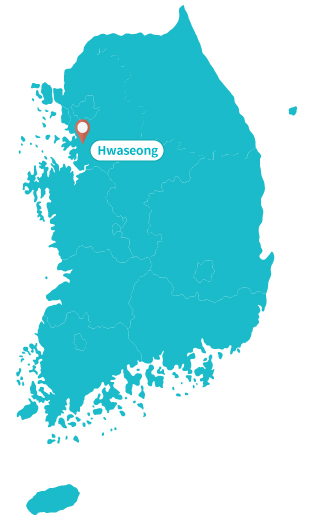Location Report
- Home
- Investment Opportunities
- Sites
- Location Report

The mobility revolution is facilitated by the convergence of cutting-edge information and communications technologies including artificial intelligence (AI), Internet of Things (IoT) and big data, and is likely to bring about various changes to people’s daily lives. Vehicles are no longer simply regarded as a means of transportation. As showcased at this year’s Consumer Electronics Show (CES), the largest consumer electronics show held annually in Las Vegas, auto makers have recently paid more attention to what drivers can experience inside the vehicle and how to improve safety. Self-driving cars, which drive autonomously while observing traffic regulations without a driver’s control, and connected-cars, which are equipped with internet access offering various infotainment services, have emerged as a mainstay of the future auto industry.
Against this backdrop, the Korean government identified the autonomous vehicles industry as one of the five new industries to support research and lower regulatory hurdles in May last year. As such, self-driving technology is expected to drive the Fourth Industrial Revolution, and the Korean government strives to secure autonomous car technologies by developing its own key auto parts, standardizing relevant technologies, and training experts and professionals. Global attention to this technology also stems from its promising potential for opening new industries and markets. Nagivant Research, a market research and consulting firm, predicted that the autonomous vehicle market will grow to KRW 210 trillion by 2020 and to KRW 1,300 trillion by 2035. In reflection of this global trend, the Korean government and private sector are planning to invest more than KRW 35 trillion in the future car industry until 2022.
The Ministry of Trade, Industry and Energy (MOTIE) unveiled a roadmap for the development of the future car industry in February last year. According to the roadmap, the Korean government and private sector will cooperate on developing core technologies for autonomous vehicles and building smart traffic systems to roll out the infrastructure necessary for completely self-driving cars by 2022. As an effort to this end, the Korean government opened “K-City,” the world’s first 5G-based autonomous vehicle testing center, in Hwaseong, Gyeonggi Province on December 10, 2018. The Ministry of Land, Infrastructure, and Transport (MOLIT) invested KRW 12.5 billion (USD 11 million) to build this 320,000-square-meter mock urban area at the Korea Transportation Safety Authority (KOSTA).
K-City has five major testing environments—a highway, downtown road, suburban street, parking lot and community facilities—for autonomous vehicles. The city also has toll gates, intersections, child protection zones, tunnels, and trees along the streets so that self-driving vehicles can be tested in real road conditions. In particular, it is the world’s first autonomous vehicle testing site connected through a 5G network. Thanks to the city’s own localized 5G network, advanced technologies for autonomous vehicles such as infotainment features can be tested at the site. This network will also allow companies, universities and research institutes to test a variety of connected car services. At its opening ceremony, mobile carriers like SK Telecom and KT showed off their technologies applicable in the auto industry utilizing 5G.
As a testament to the government’s objective to commercialize Level 3 autonomous vehicles by 2020, the government held a test-drive event on June 17, 2018 to provide the general public a first-hand experience of autonomous vehicles and to see the technologies at work. A Level 3 car, if fully developed, will allow lane changes and other autonomous driving functions to work without intervention by the driver. A classification of self-driving cars can be broken down to six-levels from no automation of Level 0 to full automation of Level 5, according to the US Society of Automotive Engineers. At the event, the cars were able to recognize nearby cars or passersby on the road, taking the necessary steps to avoid collision. Regarding the infrastructure that enables self-driving cars to hit the road, the government will establish a three-dimensional, high-precision navigation map that will cover 5,000 km of highways by 2020 and will also establish a “smart road” system that allows sensors built into roadsides to communicate with autonomous vehicles on the roads.
The government will review regulations and ready a safety system before putting autonomous vehicles on the roads in the near future. During a state affairs review meeting presided over by the country’s prime minister in November last year, the government announced a roadmap that proactively tackles regulations on self-driving cars. Under the guidelines, the government will establish an insurance system for autonomous vehicles and improve regulations on observation and location information collection. It will also introduce a simplified license system for self-driving cars and expand driver targets. The guidelines for self-driving vehicles, in particular, introduces 30 regulatory issues in four areas—driving subject, vehicle and equipment, operations, and infrastructure—and provides improvement plans.
In line with various efforts to promote autonomous vehicles, MOLIT plans to invest an additional KRW 31 billion in K-City by 2021 to create a testing environment for autonomous vehicles in severe weather conditions. In addition, it will build an industrial complex that is designed to support the Fourth Industrial Revolution in the southern part of K-City by 2021. It aims to expand the complex from 30,000 sq. meters at phase 1 in 2019 to 230,000 square meters at phase 3 in 2021.
According to a global market researcher HIS Markit, more than 51,000 autonomous vehicles are estimated to be sold globally in 2021, 1 million units in 2025, and 33.7 million units in 2040. Upon such predictions, K-City and related government policies are expected to lay the foundation for Korea’s auto industry to take another leap forward.
Source: Yonhap News Agency; The Ministry of Trade, Industry and Energy (MOTIE); The Ministry of Land, Infrastructure, and Transport (MOLIT); Newsis; Pulse by Maeil Business News











